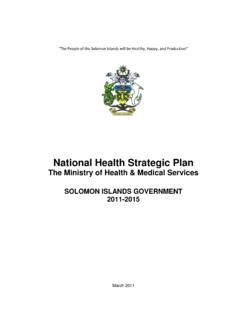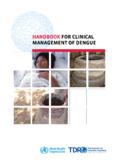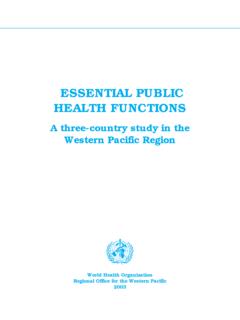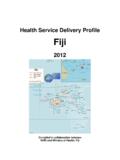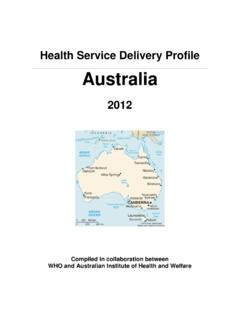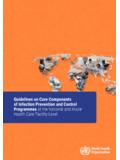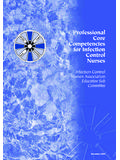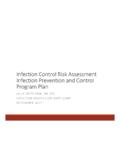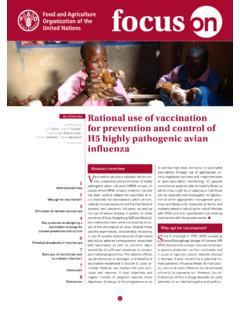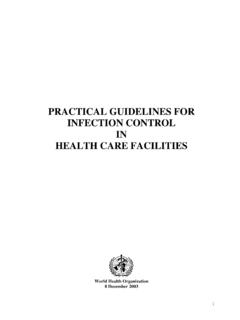Transcription of Practical Guidelines for Infection Control in Health Care ...
1 Practical Guidelines for Infection Control in Health Care Facilities World Health Organization World Health Organization Regional Office for Western Pacific, Manila Regional Office for Western Pacific, Manila Regional Office for South-East Asia, New Delhi Regional Office for South-East Asia, New Delhi SEARO Regional Publication No. 41. WPRO Regional Publication Practical Guidelines for Infection Control in Health Care Facilities World Health Organization Regional Office for Western Pacific, Manila Regional Office for South-East Asia, New Delhi WHO Library Cataloguing in Publication Data World Health Organization, Regional Office for South-East Asia and Regional Office for Western Pacific Practical Guidelines for Infection Control in Health care facilities.
2 1. Infection Control . 2. Health facilities - standards. 3. Severe acute respiratory syndrome - prevention and Control . 4. Communicable disease Control - methods. 5. Practice Guidelines . I. Title. II. SEARO Regional Publication No. 41. III. WPRO Regional Publication. (NLM classification: WX 167). ISBN 92 9022 238 7. World Health Organization 2004. Publications of the World Health Organization enjoy copyright protection in accordance with the provisions of Protocol 2 of the Universal Copyright Convention. For rights of reproduction or translation, in part or in toto, of publications jointly issued by the WHO Regional Office for South-East Asia and the WHO Regional Office for Western Pacific Region, applications should be made to the Regional Office for South-East Asia, World Health House, Indraprastha Estate, New Delhi 110002, India or the Regional Office for Western Pacific, United Nations Avenue, 1000 Manila, Philippines.
3 The designations employed and the presentation of the materials in this publication do not imply the expression of any opinion whatsoever on the part of the Secretariat of the World Health Organization concerning the legal status of any country, territory, city or area or of its authorities, or concerning the delimitation of its frontiers or boundaries. The views expressed in this publication are those of the authors and do not necessarily reflect the decisions or the stated policy of the World Health Organization; however, they focus on issues that have been recognized by the Organization and Member States as being of high priority. Printed in India Contents Foreword ..vii 1. Introduction .. 1. Background.
4 1. Infection Control precautions .. 1. Purpose .. 2. Objectives .. 2. Use of the Guidelines .. 3. 2. Infection Control 4. Need for an Infection Control programme .. 4. What is an Infection Control programme? .. 5. Organization of an Infection Control programme .. 6. Infection Control committee .. 6. Infection Control team .. 7. Infection Control manual .. 8. Education and training of Health care staff .. 9. 3. Infection Control 10. Standard precautions .. 10. Hand washing and Antisepsis (hand hygiene) .. 11. Use of personal protective equipment .. 11. Management of Health -care waste .. 15. Additional (transmission-based) precautions .. 15. Airborne precautions .. 15. Droplet precautions .. 16. Contact precautions.
5 17. Patient placement and transportation of patients .. 17. Patient placement .. 17. Spacing between beds .. 17. Single rooms .. 18. Anterooms .. 18. Cohorting .. 18. Transportation of patients .. 18. 4. Environmental Management 19. Premises/buildings .. 19. Air .. 20. Ventilation .. 20. Special air handling for airborne precautions .. 20. Protective environment .. 21. Water .. 21. Safe drinking water .. 21. Cleaning of the hospital environment .. 22. Waste management .. 22. Principles of waste management .. 23. Treatment of hazardous and clinical/infectious waste .. 23. Methods of disposal .. 24. Laundry .. 26. General instructions .. 26. Reprocessing of instruments and equipment .. 27. Reprocessing Principles.
6 27. Cleaning, disinfection and sterilization .. 30. Cleaning .. 30. Selection of disinfectant .. 33. Sterilization .. 34. Special consideration Creutzfeldt-Jacob disease .. 37. Practical Guidelines for Infection Control in Health Care Facilities iv 5. Care of Health Care Workers .. 46. Exposure to human immunodeficiency virus (HIV) .. 46. Exposure to hepatitis B virus .. 47. Exposure to hepatitis C virus .. 47. Sharp injuries .. 48. Tuberculosis .. 48. Meningococcal meningitis .. 48. SARS .. 48. Other infections ; varicella, influenza, pertussis, diphtheria, rabies .. 49. 6. Infection Control Precautions for Selected Situations .. 50. Severe acute respiratory syndrome (SARS) .. 50. Causative agent .. 50.
7 Susceptibility .. 51. Clinical picture in SARS patients .. 51. Clinical case definition of SARS .. 52. Laboratory case definition of SARS .. 52. Infection Control precautions for SARS .. 53. Transportation of patients with SARS .. 54. Personal protective equipment used for SARS .. 54. Waste disposal .. 55. Specimen collection and transportation .. 56. Hospital screening, admission procedures and triage .. 56. Care of SARS patients in isolation .. 56. Discharging the patient .. 59. Care of the deceased .. 60. Post-mortem .. 60. infections with multidrug resistant organisms .. 62. Appropriate antimicrobial use .. 62. Antimicrobial use committee .. 63. Contents v Control of endemic antibiotic resistance.
8 63. Methicillin-resistant Staphylococcus aureus (MRSA) .. 63. Vancomycin-resistant enterococcus (VRE) .. 64. Multidrug-resistant tuberculosis (MDR-TB) .. 65. infections with viral haemorrhagic fevers .. 67. Mode of transmission .. 67. Infection Control precautions .. 67. References .. 69. Further Reading .. 71. Glossary .. 72. Acronyms .. 75. Annexes 1. Hand Washing .. 76. 2. Personal Protective Equipment .. 81. 3. Infection Control : A Quick Reference Guide for 93. 4. Suggested Checklist for SARS Trolley/Table .. 95. 5. Isolation room .. 96. 6. Infection Control Advice to Contacts of Suspect or Probable SARS cases .. 97. Acknowledgements .. 102. Practical Guidelines for Infection Control in Health Care Facilities vi Foreword The World Health Organization has recognized severe acute respiratory syndrome (SARS) as the first serious and readily transmissible disease to emerge in the 21st century.
9 Despite rapid progress towards understanding the disease and the mode of transmission of the SARS virus, many gaps need to be filled. During the SARS. outbreak, it was apparent that the virus easily spread through close hospital contact with infected persons. In fact, in all severely affected countries, Health care facilities became the focal points for the spread of the disease. In the absence of any effective treatment and vaccine, Health authorities resorted to basic public Health measures. Rapid case detection, immediate isolation, contact tracing and good Infection precautions were instituted to prevent further Infection . However, as SARS spread, it became obvious that many countries lacked the necessary infrastructure, facilities, equipment and trained personnel to provide appropriate Infection Control measures.
10 Health care facilities, in both developed and developing countries, were far from being prepared to deal with the situation. In this context, it is essential that all countries strengthen their surveillance and response systems as well as their Infection Control capacities. These Guidelines , jointly prepared by the WHO Regional Offices for South- East Asia and the Western Pacific, should help countries to strengthen their Infection Control practices in Health care facilities. This would help to prevent further spread of Infection and to deal effectively with new infectious diseases like SARS as well as other hospital-associated infections . The Guidelines address all aspects of an Infection Control programme with special attention being paid to SARS.



